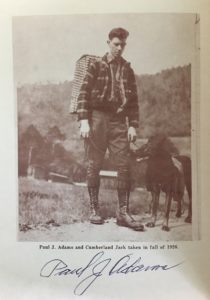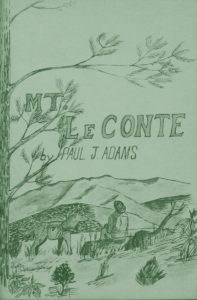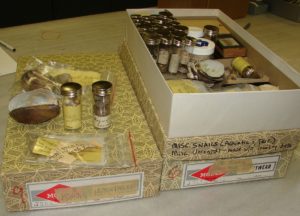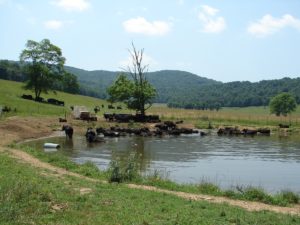Paul Adams
Paul J. Adams’ Contributions to Tennessee Natural History
Paul J. Adams is a name relatively well-known to those familiar with the history of Great Smoky Mountains National Park. A passionate, dedicated hiker and explorer, Paul Adams acted as the steward of the first official campsite on top of Mt. LeConte and subsequently worked as a paid trail guide for visiting dignitaries and tourists throughout the Smokies. However, the recent discovery of unpublished essays by Adams sheds new light on his considerable contributions to what is known about the natural world in Tennessee.

Paul Adams and Cumberland Jack at the Mountain View Hotel, Gatlinburg, 1926 from Adams’ “Mt Le Conte” published in 1966. (Courtesy of Paul James.)
Born in 1901, the son of a Presbyterian minister, Paul J. Adams was raised in Illinois before moving to North Carolina at a young age. Inspired by his father’s weekend family nature walks, Paul began writing nature journals when he was six years old and which he continued during his entire life. Family camping trips to the Great Smoky Mountains fueled his fascination with wildlife and he began assembling an impressive collection of native butterflies and moths as well as what would one of the largest collections of mollusks then in existence. This was impressive stuff for a youngster who had spent part of his childhood bedridden.
As young man Paul Adams co-founded the East Tennessee Ornithological Society in late 1923 along with seasoned naturalists including Harry Ijams, Arthur Ogden, Brockway Crouch and others – a growing band of passionate bird watchers who had formed a break-away group from the East Tennessee Audubon Society to focus on bird study. The fledgling club rallied around the sightings of a nesting pair of barn owls on Dickenson Island (now Island Home Airport) downstream from Knoxville. In 1931, Adams summarized the first decade of bird counts at what the Knoxville News Sentinel dubbed The City of Birds, a 1,000-acre sanctuary either side of the Tennessee River known for its abundant avian residents. At its inception, the East Tennessee Bird Reservation, as it was formerly known, was a monumental achievement and recognized as one of the largest protected bird reserves in the state at that time.
In his later years, Paul Adams reflected, “Mr. Harry P. Ijams of Knoxville has been on all expeditions, as he and Mr. Harry Fortner, now of the University of Vermont, started the census taking idea in 1922. In 1923, Mr. Ijams and I took the list. Nearly all the birds found in the vicinity of Knoxville are to be found on the Reservation. During the eight of the ten years it has been my rare privilege to be on the check list days.” Enjoying the company of such seasoned experts would serve Adams well during his time in the Great Smoky Mountains.
Back in 1918, Paul Adams had made his first memorable trip up Mt. LeConte and it was a trek that was life changing; he went onto climb the mountain more than 500 times during his lifetime.
Living in Knoxville, he worked a while at Brockway Crouch’s florist store on Gay Street, a regular meeting place for avid hikers embracing the Smokies. In addition to being a co-founder of the Great Smoky Mountains Hiking Club, Adams’ rapidly evolving knowledge of the mountains came to the notice of Colonel David Chapman, leader of the Smoky Mountains Conservation Association, and after a tip from Harry Ijams, Adams was awarded the job of creating and managing the first campsite on Mt. LeConte during the summer of 1925. Adams continued to develop the site throughout the remainder of the year before Jack Huff took over and built the first cabins on the peak. The trail from the current lodge to Clifftop where hikers still hope to enjoy a beautiful sunset was blazed by Adams during that first summer.
Although Adams wrote about his years working in the Smokies in his 1966 book, Mt. LeConte, he captured other adventures in an unpublished manuscript simply entitled Cumberland Jack about his legendary police dog that could carry up to 30 pounds of supplies in specially-made saddlebags across his back. A copy held in the University of Tennessee’s archives reveals a touching portrait of a man and his best friend enjoying the trials and tribulations of mountain life amidst natural splendor and speak to what a passionate, dedicated woodsman Paul Adams really was. However, with ever increasing visitation to the Smokies, largely encouraged by the fledgling movement to give it National Park status, there was also a serious side to Adams’ work; a watchful eye was needed to prevent deadly forest fires caused by inexperienced hikers. Those were important days.
After a spell as a paid trail guide at the Mountain View Hotel in Gatlinburg, Paul Adams spent several years in the small community of Alpine in middle Tennessee. Although Cumberland Jack had proved his worth in the Smokies, the dog still had a large role to play in Adams’ life.
The duo’s experience thwarting forest fires came back into play helping extinguish two potentially lethal fires on Alpine Mountain. Adams surprised everyone by pulling out Jack’s retired saddlebags to carry supplies up to the locals attempting to dampen the flames. Another time, Cumberland Jack further endeared himself with the locals after wrestling and taming an unruly bull in a nearby pasture. The bull, apparently, was not amused.
In 1935, Paul Adams moved from Alpine the short distance across the Cumberland Plateau to Crab Orchard where he lived the rest of his life. It was here that he continued to expand his wildlife knowledge and became one of the earliest naturalists to document wildlife in Cumberland County. During the 1950s, Adams reflected on the fertile landscape surrounding his home, calling the Cumberland Plateau “a naturalist’s delight” and “the Noah’s Ark of the vegetable kingdom” due to the isolation of wildlife not destroyed during the glacial period in Tennessee’s highland region. He recorded “40 plants in the Cumberland’s which are not known elsewhere in the world. It is virgin territory as far as plants, mosses and lichens are concerned.”
At that time, no formal study of plant life had been undertaken throughout Cumberland County. Although not formally exhaustive, Adams documented a staggering number of species, including 121 native trees, 450–500 herbaceous plants (including seven species of Trillium and rare fern species documented along with Dr. H.M. Jennison, botanist with University of Tennessee), 223 species of birds, and 41 species of animals, including the then rare bit still extant panther. In his writings, Adams noted that the last gray wolf was seen in 1885 at Wolf Den Branch near Yellow Creek.
In September 1940, Adams witnessed a memorable migration of Cooper’s Hawks, estimating 2,000 birds passing overhead on the Cumberland Plateau. Another bird which fascinated Adams was the Lark Sparrow. After first noticing it in early March and believing it to be a migrant, the sparrow continued to hang around until late May. Adams considered this a “thrill of a lifetime” and posed the question, “Just why the writers of poetry have not sung of the praises of this grassland bird I do not know, for the song once heard will be listened for again and again.”
Local Natural Historian. That is how Paul Adams referred to himself on his stationary during the 1920s. It was really his epitaph. He passed away in 1985, leaving the state of Tennessee bereft of one of its most talented yet largely unrecognized naturalists. Yet, Adams’ legacy lives on through his journals, photographs and scrapbooks that he left to the Tennessee State Library and Archives, offering a fascinating record of one man’s contributions to natural Tennessee.
The Mollusk Collector
Over the years, Paul Adams donated a large part of his mollusk collection to the University of Tennessee in Knoxville. Included are freshwater bivalves (mussels), and aquatic and terrestrial gastropods (snails) that Adams himself collected across a broad area of Tennessee from the Little Pigeon River, Norris, Murfreesboro, Cumberland County and many locations in between.
Quite a few of his specimens are stored in modern zip lock bags but they contain his original handwritten notes and often accompanied by yellowing strips of newspaper from the day of collection. After all these years it would be tempting to think that such a collection would be gathering dust somewhere in the basement of the University campus.
Far from it; on the day I inquired about the collection’s whereabouts, Gerry Dinkins, Curator of Malacology at UT’s Frank H. McClung Museum, was actually working with a group of graduate and undergraduate students who were accessioning material including terrestrial gastropods from the Geology department and aquatic gastropods from the Wildlife and Fisheries Science Department. Interestingly, Adams collected some of what are now considered very rare specimens. For the layman, their common names are unusual if not mysterious: the threehorn wartyback and orangefoot pimpleback conjure up strange visuals. However, the equally bizarre sounding turgid blossom, sugarspoon, and dromedary pearlymussel, all collected by Adams in the 1920s and early 1930s have subsequently become both locally extirpated and outright extinct. So, even after 70 or 80 years, Paul Adams’ attempts to document Tennessee’s molluscan biodiversity is stilling relevant to modern academia. Paul Adams would have been genuinely pleased about that.
The Lost Files
It is the thrill of any researcher to be handed a file containing rare and previously unseen writings of a legend. Such was the case when I met Marcia Davis, member of the Knoxville Chapter of the Tennessee Ornithological Society and author of the weekly bird column in the Knoxville News Sentinel. Marcia proved a great help when I wrote the history of the Ijams family back in 2010 and considered Ijams Nature Center to be a trustworthy recipient of such a treasure trove that she had acquired by chance many years ago. The yellowing file contained a number of original typewritten essays by Paul Adams, including Natural History and Birds of the Cumberland Plateau (1952), Spring Migration at Knoxville, Tennessee (1931), plus many pages of handwritten lists of birds seen in the Knoxville area as compiled by Adams and Harry Ijams between 1920 and 1931. Also inside the file were copies of Adams’ banding permits and Bird Migration Records detailing birds and eggs taken from the wild for study and sent officially to the United States Department of Agriculture. It is a fascinating glimpse of a meticulous and dedicated naturalist in action at a time when the state’s fledgling birding movement was pregnant with possibilities.
Notes from the Field (2102)
Alpine, Tennessee, lays six miles east of Livingston along Highway 52 towards Jamestown. A “blink-and-miss-it” settlement; the 400 or so inhabitants undoubtedly prefer it that way; only road traffic disturbance invades rich farm pasture and rural living.
Although not a domineering peak, Alpine Mountain rises 1,000 feet above the valley behind a farm owned by Kent Copeland, whose family has resided here for almost a century. When I stopped to inquire the exact location of Alpine mountain, Mr. Copeland responded in fine Tennessee hospitality; he put away his ride-on mower and offered to take me out on his farm to get a closer view of the mountain. From half way up the hillside we confirmed the location of the local church where Paul Adams’ father, Reverend Clair S. Adams was pastor during the late 1920s and early 1930s.
Hardly visible from the road, the delightful church is charming in its setting and architecture and I was delighted to discover a plaque honoring Reverend Adams imbedded in the exterior of the church. The Adams family name is most likely forgotten to history by most of the local population. Likewise, the memory of the day that the pastor’s son and his remarkable dog helped save Alpine Mountain from a tragic forest fire is equally gone.
Yet the local farmers and infrequent visitors (like me) can bless the day that Paul Adams and Cumberland Jack helped save the mountain all those years ago. It was a selfless act that protected the landscape and its wildlife that call Alpine Mountain home.
This article, written by Paul James, originally appeared in the Tennessee Conservationist, January/February issue, 2013.










